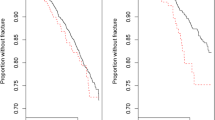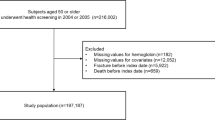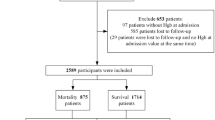Abstract
Summary
The relationship between hemoglobin and hip fracture was examined in older non-Hispanic white adults from the third National Health and Nutrition Examination Survey (NHANES III). Both low and high hemoglobin values were associated with increased hip fracture risk before and after adjusting for selected risk factors.
Introduction
The few studies to date that have examined the relationship between hemoglobin and fracture risk have focused on low hemoglobin values. The present study examined hip fracture risk across the hemoglobin distribution in older non-Hispanic white adults from the third National Health and Nutrition Examination Survey (NHANES III, 1988–1994).
Methods
Hemoglobin was measured using a Coulter S-plus Jr.® (Coulter Electronics, Hialeah, FL) in 2,122 non-Hispanic whites age 65 years and older. Hip fracture cases were identified using linked Medicare and mortality records obtained through 2007. Cox proportional hazards models were used to assess the best-fitting model and to estimate the hazards ratio (HR) for hip fracture by hemoglobin decile before and after adjusting for selected confounders.
Results
There were 239 hip fracture cases in the analytic sample. The best fitting model was quadratic. When compared to values in the middle of the distribution, those with hemoglobin in the lowest and highest deciles had increased hip fracture risk (HRlowest decile = 2.96, 95 % confidence interval (CI) 1.44–6.08; HRhighest decile = 2.06, 95 % CI 1.09–3.92) after adjusting for age and sex. Both HRs remained significant after adjusting for additional confounders (HRlowest decile = 2.24, 95 % CI 1.09–3.92; HRhighest decile = 2.37, 95 % CI 1.35–4.16).
Conclusions
Both low and high hemoglobin values were associated with increased hip fracture risk. The mechanism underlying the relationship is not clear, but there were some suggestions that it may differ for low versus high hemoglobin.

Similar content being viewed by others
Notes
Respondents were ineligible for linkage to CMS administrative records if they were missing key identification data and/or if they did not provide their Social Security or Medicare number at baseline or did not have a Social Security number verified by the Social Security Administration’s Enumeration Verification System.
References
Lobo A, Gaievski E, Colli C (2011) Hemoglobin regeneration efficiency in anemic rats: effects on bone mineral composition and biomechanical properties. Biol Trace Elem Res 143:403–411
Katsumata S-I, Tsuboi R, Uehara M, Suzuki K (2006) Dietary iron deficiency decreases serum osteocalcin concentration and bone mineral density in rats. Biosci Biotechnol Biochem 70:2547–2550
Katsumata S-I, Tsuboi R, Uehara M, Suzuki K (2009) Severe iron deficiency decreases both bone formation and bone resorption in rats. J Nutr 139:238–243
Cesari M, Pahor M, Lauretani F et al (2005) Bone density and hemoglobin levels in older persons: results from the InCHIANTI study. Osteoporos Int 16:691–699
Laudisio A, Marzetti E, Pagano F, Bernabei R, Zuccala G (2009) Haemoglobin levels are associated with bone mineral density in the elderly: a population-based study. Clin Rheumatol 28:145–151
Korkmaz U, Korkmaz N, Yazici S, Erkan M, Baki AE, Yazici M, Ozhan H, Ataoglu S (2012) Anemia as a risk factor for low bone mineral density in postmenopausal Turkish women. Eur J Intern Med 23:154–158
Guralnik JM, Eisenstaedt RS, Ferrucci L, Klein HG, Woodman RC (2004) Prevalence of anemia in persons 65 years and older in the United States: evidence for a high rate of unexplained anemia. Blood 104:2263–2268
Chen Z, Thomson CA, Aickin M, Nicholas JS, Van Wyck D, Lewis CE, Cauley JA, Bassford T, Investigato WHI (2010) The relationship between incidence of fractures and anemia in older multiethnic women. J Am Geriatr Soc 58:2337–2344
Jorgensen L, Skjelbakken T, Lochen ML, Ahmed L, Bjornerem A, Joakimsen R, Jacobsen BK (2010) Anemia and the risk of non-vertebral fractures: the Tromso study. Osteoporos Int 21:1761–1768
Duh MS, Mody SH, Lefebvre P, Woodman RC, Buteau S, Piech CT (2008) Anaemia and the risk of injurious falls in a community-dwelling elderly population. Drugs Aging 25:325–334
Chaves PHM, Ashar B, Guralnik JM, Fried LP (2002) Looking at the relationship between hemoglobin concentration and prevalent mobility difficulty in older women. Should the criteria currently used to define anemia in older people be reevaluated? J Am Geriatr Soc 50:1257–1264
Zakai NA, Katz R, Hirsch C et al (2005) A prospective study of anemia status, hemoglobin concentration, and mortality in an elderly cohort: the Cardiovascular Health Study. Arch Intern Med 165:2214–2220
Culleton BF, Manns BJ, Zhang J, Tonelli M, Klarenbach S, Hemmelgarn BR (2006) Impact of anemia on hospitalization and mortality in older adults. Blood 107:3841–3846
Centers for Disease Control and Prevention National Center for Health Statistics (1994) Plan and Operation of the Third National Health and Nutrition Examination Survey, 1988–94. In Department of Health and Human Services (ed) Series 1: Programs and collection procedures. Centers for Disease Control and Prevention, National Center for Health Statistics, Hyattsville MD, pp 1–407
Centers for Disease Control and Prevention National Center for Health Statistics (2012) NCHS data linked to mortality files. Centers for Disease Control and Prevention, National Center for Health Statistics. http://www.cdc.gov/nchs/data_access/data_linkage/mortality.htm
Centers for Disease Control and Prevention National Center for Health Statistics (2012) NCHS Data linked to CMS Medicare enrollment and claims files. Centers for Disease Control and Prevention, National Center for Health Statistics. http://www.cdc.gov/nchs/data_access/data_linkage/CMS_Medicare.htm
Ray WA, Griffin MR, Fought RL, Adams ML (1992) Identification of fractures from computerized medicare files. J Clin Epidemiol 45:703–714
Taylor AJ, Gary LC, Arora T et al (2011) Clinical and demographic factors associated with fractures among older Americans. Osteoporos Int 22:1263–1274
American Medical Association (2010) CPT (Current Procedural Terminology) Assistant Archives 1990–2009. American Medical Association, Chicago
National Center for Health Statistics (2010) Conversion table of new ICD-9-CM codes. National Center for Health Statistics, http://www.cdc.gov/nchs/data/icd/ICD-9-CM_FY14_CNVTBL_Final.pdf
Looker AC (2013) Serum 25-hydroxyvitamin D and risk of major osteoporotic fractures in older U.S. adults. J Bone Miner Res 28:997–1006
McMullin MF (2008) The classification and diagnosis of erythrocytosis. Int J Lab Hematol 30:447–459
Gunter EW LB, Kokickowski SM (1996) Laboratory methods used for the third National Health and Nutrition Examination Survey (NHANES III), 1988–1994. In Centers for Disease Control NCfHS (ed). Centers for Disease Control, National Center for Health Statistics, http://www.cdc.gov/nchs/data/nhanes/nhanes3/cdrom/nchs/manuals/labman.pdf
Looker AC, Dallman PR, Carroll MD, Gunter EW, Johnson CL (1997) Prevalence of iron deficiency in the United States. JAMA 277:973–976
Pfeiffer CM, Johnson CL, Jain RB, Yetley EA, Picciano MF, Rader JI, Fisher KD, Mulinare J, Osterloh JD (2007) Trends in blood folate and vitamin B-12 concentrations in the United States, 1988 2004. Am J Clin Nutr 86:718–727
Wahner HW, Looker A, Dunn WL, Walters LC, Hauser MF, Novak C (1994) Quality control of bone densitometry in a national health survey (NHANES III) using three mobile examination centers. J Bone Miner Res 9:951–960
Cockcroft DW, Gault MH (1976) Prediction of creatinine clearance from serum creatinine. Nephron 16:31–41
Ostchega Y, Harris TB, Hirsch R, Parsons VL, Kington R, Katzoff M (2000) Reliability and prevalence of physical performance examination assessing mobility and balance in older persons in the US: data from the Third National Health and Nutrition Examination Survey. J Am Geriatr Soc 48:1136–1141
Research Triangle Institute (2008) SUDAAN language manual, Release 10.0. Research Triangle Institute, Research Triangle Park, NC
Korn EG, Graubard B (1999) Analysis of health surveys. John Wiley & Sons, New York
Li GF, Pan YZ, Sirois P, Li K, Xu YJ (2012) Iron homeostasis in osteoporosis and its clinical implications. Osteoporos Int 23:2403–2408
Johnell O, Kanis JA, Oden A et al (2005) Predictive value of BMD for hip and other fractures. J Bone Miner Res 20:1185–1194
Kanis JA, Johnell O, De Laet C et al (2004) A meta-analysis of previous fracture and subsequent fracture risk. Bone 35:375–382
Kanis JA, Johnell O, Oden A et al (2005) Smoking and fracture risk: a meta-analysis. Osteoporos Int 16:155–162
Kanis JA, WHO Scientific Group on Assessment of Osteoporosis at the Primary Health-care Level (2007) Assessment of osteoporosis at the primary health-care level. World Health Organization, Geneva
Chaves PHM (2008) Functional outcomes of anemia in older adults. Semin Hematol 45:255–260
Merchant AA, Roy CN (2012) Not so benign haematology: anaemia of the elderly. Br J Haematol 156:173–185
Nissenson AR, Goodnough LT, Dubois RW (2003) Anemia: not just an innocent bystander? Arch Intern Med 163:1400–1404
Patel KV, Harris TB, Faulhaber M, Angleman SB, Connelly S, Bauer DC, Kuller LH, Newman AB, Guralnik JM (2007) Racial variation in the relationship of anemia with mortality and mobility disability among older adults. Blood 109:4663–4670
Dong X, de Leon CM, Artz A, Tang Y, Shah R, Evans D (2008) A population-based study of hemoglobin, race, and mortality in elderly persons. J Gerontol A: Biol Med Sci 63:873–878
Patel KV, Longo DL, Ershler WB, Yu B, Semba RD, Ferrucci L, Guralnik JM (2009) Haemoglobin concentration and the risk of death in older adults: differences by race/ethnicity in the NHANES III follow-up. Br J Haematol 145:514–523
Centers for Disease Control and Prevention (1998) Recommendations to prevent and control iron deficiency in the United States. Centers for Disease Control and Prevention. MMWR Recommendations and reports : Morbidity and Mortality Weekly Report Recommendations and reports/Centers for Disease Control 47:1–29
Guralnik JM, Ershler WB, Schrier SL, Picozzi VJ (2005) Anemia in the elderly: a public health crisis in hematology. ASH Educ Prog Book 2005:528–532
Conflicts of interest
None. The findings and conclusions in this report are those of the authors and do not necessarily represent the views of the Centers for Disease Control and Prevention.
Author information
Authors and Affiliations
Corresponding author
Rights and permissions
About this article
Cite this article
Looker, A.C. Hemoglobin and hip fracture risk in older non-Hispanic white adults. Osteoporos Int 25, 2389–2398 (2014). https://doi.org/10.1007/s00198-014-2769-3
Received:
Accepted:
Published:
Issue Date:
DOI: https://doi.org/10.1007/s00198-014-2769-3




